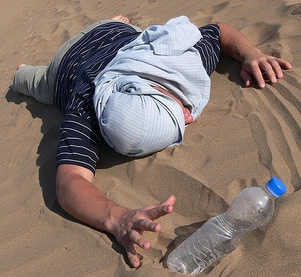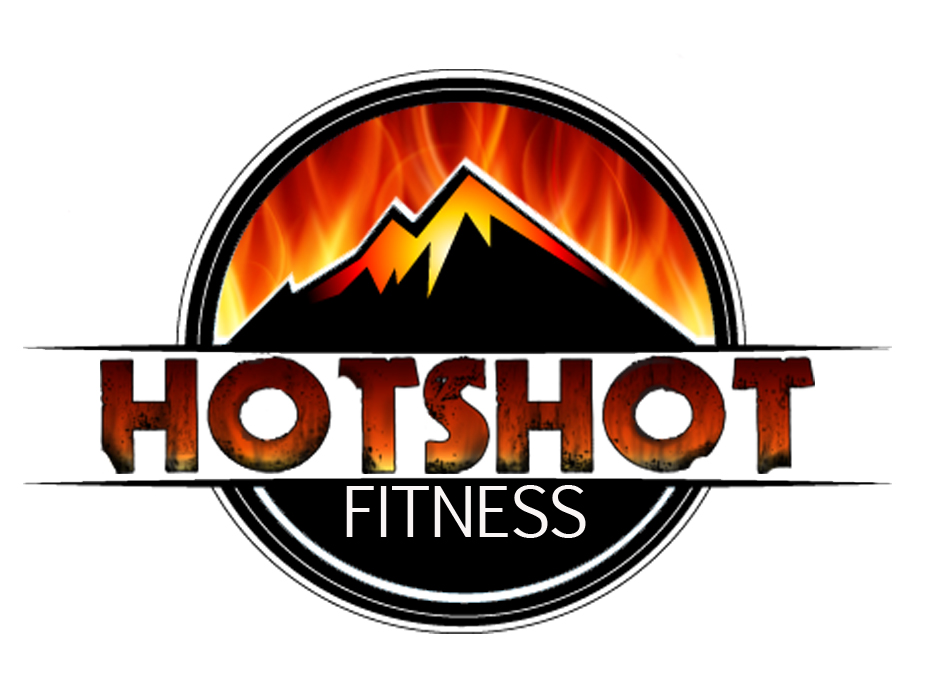Are you drinking enough water? If you look like this guy after a five mile run – probably not.
 You’ve felt like a man stranded in the desert plenty of times before. Your mouth feels and tastes like a bottle of Gold Bond exploded in it. Your legs have morphed into inanimate stone pillars and continually cramp up, causing severe pain (you can find out what to do about leg cramps by following the link). Whenever you lick your lips, it tastes like the ocean. It’s all too obvious when we’re seriously dehydrated. But even mild dehydration can have serious implications.
You’ve felt like a man stranded in the desert plenty of times before. Your mouth feels and tastes like a bottle of Gold Bond exploded in it. Your legs have morphed into inanimate stone pillars and continually cramp up, causing severe pain (you can find out what to do about leg cramps by following the link). Whenever you lick your lips, it tastes like the ocean. It’s all too obvious when we’re seriously dehydrated. But even mild dehydration can have serious implications.
Think about it: Have you hit a plateau in your training? Or some days, just feel like you’re out of it? There’s a chance that your declining performance could be related to your hydration – or lack thereof. If you’re dehydrated, your performance will suffer. It’s as simple as that.
In a study in the Journal of Applied Physiology, researchers found that dehydrated subjects performed substantially worse during exercises when compared to previous performances when they were well-hydrated.
In another paper titled “Rehydration and Recovery after Performance” by Ronald Maughan, Ph.D., John B. Leiper and Susan M. Shirreffs, the authors write:
“Dehydration and the associated problem of hyperthermia are two major factors that limit exercise capacity. In prolonged exercise, especially when the ambient temperature and humidity are high, a progressive dehydration seems to be almost inevitable because fluid intake usually fails to match sweat losses. The resulting loss of performance is accentuated if the athlete begins exercise in a state of hypohydration. Even in events of short duration, where there is little sweat loss, performance is impaired if the athlete is not fully hydrated at the start of exercise (Sawka & Pandolf, 1990).”
So, how much water should you be drinking?
Wildland firefighters need to be drinking at least 1 quart of fluid per hour during hard work (Domitrovitch & Sharkey, 2008). ONE QUART! If you’re hacking line for eight hours, you need to be consuming two gallons of fluid to compensate for all the fluid lost to sweat. They also recommend that between 1/3 and 1/2 of all fluid consumed during a shift should be a sports drink. But why a sports drink? Why not just regular water? Ever look at your yellow after an assignment? Notice how the straps of your line gear are neatly outlined in a white crust? That white crust is salt. Salt that once was in your body, doing good things. You need to get that salt (and other electrolytes like Potassium) back into your system.
Plain water is not the best beverage to be consumed following exercise to replace the water lost as sweat (Costill & Sparks, 1973; Gonzalez-Alonso et al, 1992; Nose et al, 1988); the replacement of electrolytes as well as water is essential for effective rehydration. Sodium is the major positively charged ion lost in sweat and is also the most abundant ion in the extracellular space. Dietary sodium is important in assisting effective rehydration, largely as a consequence of its role as the major ion of the extracellular fluid. If sufficient amounts of sodium and water are ingested, plasma osmolality and sodium concentration do not decline, as may occur if plain water is ingested. (Maughan, Leiper, Shirrefs, 1996)
And completely serious, the Federal Government has published a paper that recommends that you regularly examine your urine for signs of dehydration. It’s good advice – but it’s still funny 😉
[pullquote]
Firefighters should monitor their hydration status during an assignment by paying attention to: Urine color. Pale yellow or wheat color urine is normal. A lighter color is a sign of overhydration. Dark yellow or brown urine is a sign of dehydration. (Domitrovitch & Sharkey, 2008)[/pullquote]
Calculate Your Fluid Loss
So, you know you should be drinking more water, but how much do you need? And more importantly, how much are you even losing when you workout? Here’s a simple test that you can do to figure it out:
- Get naked. Get on the scale. Don’t have a scale? We got you covered. Digital scales like the Fitbit Aria Scale are awesome. They’re wifi connected, and sync with your Fitbit’s dashboard. Plus, a digital scale will provide weight to the tenth decimal place (e.g. 187.4) which will offer a more accurate measure. Plus, it’s not like trying to read a seismographic during an earthquake. Since there’s no needle, it doesn’t fluctuate with every involuntary muscle movement that you make.
- Write down your weight pre-workout.
- Work the hell out
- Get back on the scale. Naked.
- Subtract the the two numbers.
- The difference between the two = water loss.
If you lost one pound, then you would need to drink 16oz to compensate for that loss.
* Thanks to the Gatorade Sports Science Institute for this handy tool.
Advice for staying hydrated
Surround yourself with water. If you have a water bottle within reach at all times, the frequency that you drink is going to increase. This is why so many people decide to invest in Custom Water so they can have a large quantity of water at hand so they can always be hydrated. But this method isn’t for everyone. If you have to get up and walk over to the fridge to grab a bottled water, most of the time, you’re going to put it off till you’re thirsty enough to justify the 10 second walk. Pickup a good old-fashioned Nalgene bottle (preferably one that’s BPA-free) and keep it around the station. That way you don’t have to worry about trashing the environment by using bottled water.
Buy a CamelBak. Preferably two. One for the fireline, and one for personal use / training. They just make your life so much easier and convenient. Canteens are a pain to access on the go while you’re hiking and working. Ever try to stuff a canteen back into your line gear while you’re hiking? Frustrating. Ever try to screw on the bottle cap while you’re hiking and holding a tool? Very frustrating. Ever dropped a bottle cap into an ash pit and wondered, “Now what the hell am I going to do with this 3/4 full canteen with no top?” For all those reasons and a few more, camelbacks are definitely the way to go. CamelBak makes a hydration system specific to wildland firefighting called, aptly enough, “The Hotshot.” It’s designed to attach easily to most line gear systems.
If you’re using a CamelBak system, it’s imperative that you keep it clean. A microbial film will develop over time, and while it most likely won’t kill you, it’ll skunk up your water, and make each sip seem like you’re biting into a rotten lemon. Camelback offers a cleaning kit for thorough cleans. It’s a good idea to give your system a good cleaning a few times during the season. And it’s also a good idea to stow a few Camelbak Cleaning Tabs in your line gear for in-the-field cleaning.
Another good rule of thumb is to never put sports drinks like Gatorade or Powerade or any of those crazy powdered-concoctions you get in MREs into your line gear canteens or CamelBak. Inevitably, the sugars will foul up your bottles and bladders and that’s just an additional expense and headache you don’t need. Stash full-bottles of Gatorade in your line gear and dispose of them when you’re done. If you keep sports drinks in a powdered form in your line gear, use your camp cup to mix it up.
Start Drinking The Moment You Wake Up. Stash a Hydro Flask next to your sleeping bag. When you wake-up, before you even roll out of your sleeping bag, drink it. That way, before you even get out of bed you’re up a liter of water, and that’s a great way to fend off dehydration for the rest of your shift.
Also, water is great for your digestion. MREs carry a bad reputation for causing…”interruptions” in a firefighters’ bowel movements, but one of the biggest causes of constipation is dehydration. Crass as it might be, you need to keep the pipes lubricated. Staying hydrated will help keep your digestive system moving along, and that’s key.
References
